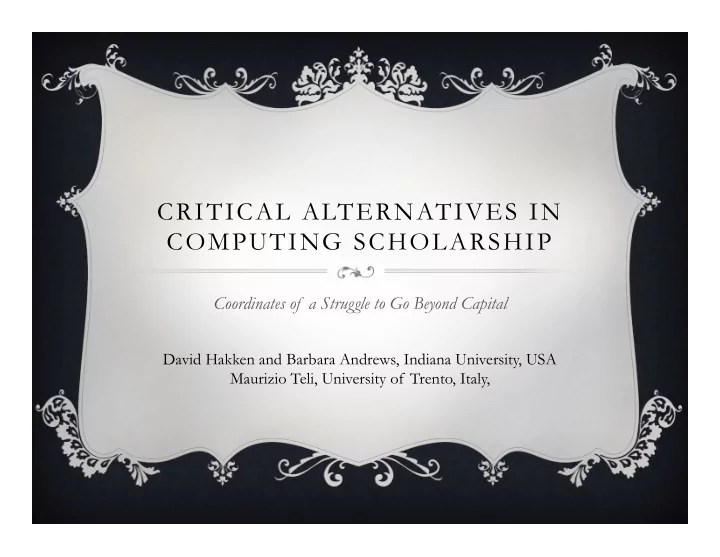

CRITICAL ALTERNATIVES IN COMPUTING SCHOLARSHIP Coordinates of a Struggle to Go Beyond Capital David Hakken and Barbara Andrews, Indiana University, USA Maurizio Teli, University of Trento, Italy,
COORDINATES OUTLINE v 1 st coordinate: Two tropes in computing narratives v 2 nd : The duality and space for a Leftist discourse on digital technologies v 3 rd : The Beyond Capital Project in brief v 4 th : An example of one value which the Project puts forward: a constructivist, critical perspective on technology design v 5 th : Constructivism and moving beyond Capital
TROPES IN COMPUTING SCHOLARSHIP v The two narrative tropes in computing scholarship, • Norbert Wiener’s socio-technical one (“recessive”) • Claude Shannon’s and Warren Weaver’s technicist one (“dominant”) v Yet both implicated in actual computing development v Hence, there is a gap between actual development and normal conceptualization; see, e.g., “openness” v How dominant presumes capitalism and its reproduction as given
A STRANGE DUALITY v Result: a strange duality, socially aware in practice, only engineeringly/ corporately in theory v Still, situation results in spaces for a domain of alternative critical scholarship, as in Participatory Design, Computer-Supported Cooperative Work, Critical Alternatives (Aarhus Conference) v Also provides space for a critical technology politics that can also be leftist v Leads to our project and our book, B EYOND C APITAL : V ALUES , C OMMONS , C OMPUTING , AND THE S EARCH FOR A V IABLE F UTURE (F ORTHCOMING F ALL , 2015, R OUTLEDGE )
BEYOND CAPITAL PROJECT v Most generally, to foster a discourse on the dynamics of social formation reproduction desirable to emerge when those of capital become marginalized; v Presumes either end of domination of these dynamics by capital or its terminal decline; v Identifies the arenas of new values or values set, institutions for these values, and measures of institutionalizational success as things on which such discourse should focus; v Finds in selected computing practices activities on which alternatives can be built. v As Utopian, but not Utopian Socialist (Engels); and v As seeing in computing a possibly revolutionary dynamic, but not a pathway to revolution.
THE BEYOND CAPITAL VALUES v As general values we extract from computing: 1. Sustainability. 2. Increased and broadened access to the means of cultural reproduction. 3. Flexibility in the Scale of Social Formation Reproduction. 4. A Broader understanding of “the economic.” 5. A social constructivist perspective on technology. 6. Democracy. v As specific values relevant to face-to-face (or screen-to-screen) interaction: 1. A Processual Approach or “Processuality.” 2. Informating As the Basic Goal of Computing. 3. A “Free Software” Approach to “Openness.” 4. A Service-Orientation. 5. Participation.
A C O N S T RU C T I V I S T PE R S PE C T I V E O N, E .G., TE C H N O LO G Y D E S I G N v To illustrate the Beyond Capital Project approach, focus on what we mean when we speak of the constructivist value, re: design • Stress co-construction of the social and the technical • Recognize need to stress the social, as technical generally over-represented • Technologies as actor networks (TAN) • As “society made durable” • Design as from somewhere, not “god view” • Infrastructuring, designing in regard to existing techs, as key • Actively mobilize all relevant constructions, including those of users • Referred to now as “public design” or “making things public”
TAKING C O NSTRU C TIVISM BE YO ND C A PITA L v To take these understanding of design beyond capital: • Recognize how design is always contestable • Can start with concerns of people, not preoccupations of designers • Undermines “god-like,” “artistic vision” view of designer’s role • Rather, main designer role is a facilitator or broker • Implications for funding: will need to be open-ended, social reproduction-based; see “digital social innovation”: • “a type of social and collaborative innovation in which innovators, users and communities collaborate using digital technologies to co create knowledge and solutions for a wide range of social needs and at a scale that was unimaginable before the rise of the Internet.” (EU DSI)
CONCLUSION v Constructivism as a value means articulating digital social innovation as public design infrastructuring; as innovation addressing societal issues without becoming subsumed to capital reproduction v Also requires interdisciplinarity v See as an example of how thinking beyond capital is both: • A guide to practice in the present (Gorz’s non-reformist reform), and • A space for considering what we want of a future beyond capital v General Project: to Foster such thinking
Recommend
More recommend